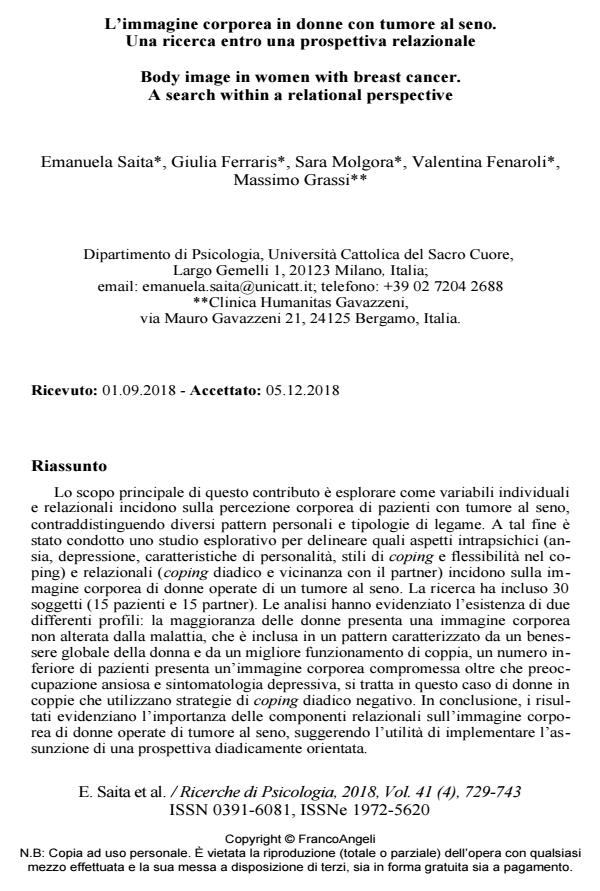Body image in women with breast cancer. A search within a relational perspective
Journal title RICERCHE DI PSICOLOGIA
Author/s Emanuela Saita, Giulia Ferraris, Sara Molgora, Valentina Fenaroli, Massimo Grassi
Publishing Year 2019 Issue 2018/4
Language Italian Pages 15 P. 729-743 File size 208 KB
DOI 10.3280/RIP2018-004011
DOI is like a bar code for intellectual property: to have more infomation
click here
Below, you can see the article first page
If you want to buy this article in PDF format, you can do it, following the instructions to buy download credits

FrancoAngeli is member of Publishers International Linking Association, Inc (PILA), a not-for-profit association which run the CrossRef service enabling links to and from online scholarly content.
The general purpose of this work is to explore how individual and relational variables can affect the well-being and the body perception of women with breast cancer, differentiating psychological patterns of cognitive, emotional and relational processes. This exploratory study investigates individual (body image, anxiety, depression, personality, coping, resilience) and relational (dyadic coping and emotional closeness to the partner) variables of 30 subjects (15 patients and 15 partners). The analysis show two different profiles: low levels of altered body perception correspond to a general overall well-being and a better couple behav-iour; otherwise anxiety, depression and worst dyadic relationship are associated with deteriorated body perception. The findings suggest the importance of rela-tional components on the overall well-being of women with Breast cancer and their partners and support the idea of a dyadically oriented perspective in study-ing breast cancer patients.
Keywords: Body image, breast cancer, anxiety, depression, dyadic coping.
- Dyadic Profiles of Couples Coping With Body Image Concerns After Breast Cancer: Preliminary Results of a Cluster Analysis Emanuela Saita, Giulia Ferraris, Chiara Acquati, Sara Molgora, Antonia Sorge, Francesco Valenti, Massimo Maria Grassi, Denise Vagnini, in Frontiers in Psychology 869905/2022
DOI: 10.3389/fpsyg.2022.869905
Emanuela Saita, Giulia Ferraris, Sara Molgora, Valentina Fenaroli, Massimo Grassi, L’immagine corporea in donne con tumore al seno. Una ricerca entro una prospettiva relazionale in "RICERCHE DI PSICOLOGIA " 4/2018, pp 729-743, DOI: 10.3280/RIP2018-004011